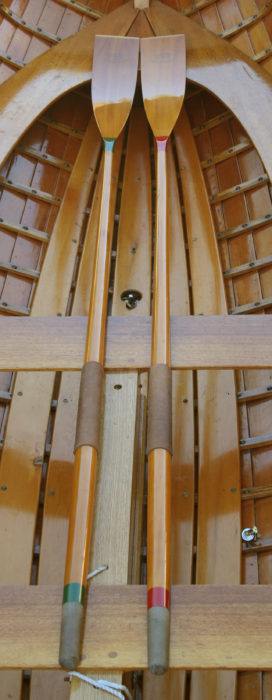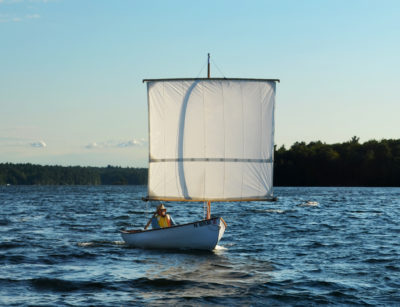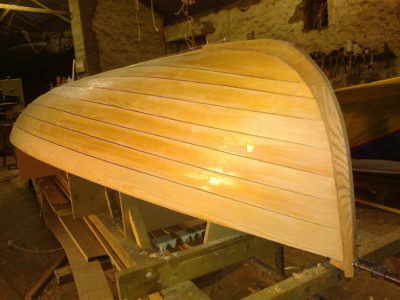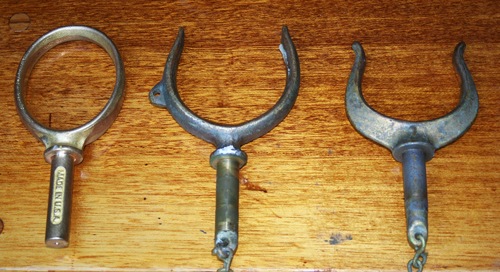For as long as I can remember, my father carved model oars in the living room. They were about a foot long, whittled from fine-grained Alaska yellow cedar and sanded silky smooth. He painted the blades with the colors of the crews he coached, and gave the oars out as prizes after rowing regattas. Standing upright in mahogany bases, they were objets d’art.
 photographs by the author
photographs by the authorThe looms taper to the grips to allow the use of closed oarlocks.
Proper oars, like almost anything meant for moving through water, should be beautiful. Tom Regan of Grapeview Point Boat Works (GPBW) in Allyn, Washington, sculpts beautiful oars and, not surprisingly, they perform effectively and gracefully. Their blades are curved along their length and across their width; the ends are squared off and capped with a hardwood tip. The looms, tight vertical-grained Sitka spruce, run through the full length of the blades, with 1¾″ pieces of the same wood glued either side to achieve the full 5 1/8″ width at the tip. The throats have a nicely shaped transition from the rounded triangular cross-section created by the wings of the blade and the central spine on the back, to the round looms.
At the leathers the looms have a diameter of 1 11/16″. The grips are unvarnished for a positive and blister-free grip, and the ends are plugged, covering holes where lead has been inserted as counterweights to balance the oars in the locks.
The oars are marked with green and red paint to indicate port and starboard, and while there’s no significant difference in their shape to require use only on one side, it’s a good idea to dedicate the oars in that manner to limit the area of wood that gets compressed during use and allow them to settle into a single orientation.
The 7′6″ oars I used weigh 3 lbs, 4.7 oz and 3 lbs, 13.6 oz, but I didn’t notice the difference until I put them on a scale. There are some slight differences in the thickness of the blades and looms, the heavier oar having the smaller dimensions, indicating that Tom did everything possible to match to weight of the oars and adapt to the variations in density of the spruce.
The locks that GPBW recommends for the oars have vertical ovals that slip over the ends of the oars (requiring lead instead of thicker loom inboard for balance). The leathers are sewn on and without buttons; their 10″ length allows adjusting the gearing of the oars.
I used the oars aboard my 14′ lapstrake Whitehall, and they were a pleasure to row with. The blades’ fine edges, slender profile, and smooth contours provide an exceptionally clean entry. The looms flex as power is applied, giving the stroke a smoother feel and, according to Andrew Steever (in Oars for Pleasure Rowing: Their Design and Use), making the oars more efficient: “…the limberness delays the acceleration of the blade slip through the water and reduces the turbulent energy losses around the blade.” My father advised rowers to “finish on a bent oar” to use the energy stored in the oar to power the finish and bring themselves upright at the end of the stroke. The flexible GPBW looms make that technique easily attainable for a recreational rower. This particular pair was made especially fine and limber to suit a rower smaller than I am; Tom makes oars to meet the requirements of individual rowers and their boats.

The smooth and slender shape of the blades allows them to slip in and out of the water cleanly, adding power to the stroke.
When I pulled very hard on the oars, the blades would flutter, but only with a single rise in the middle of the stroke. I was able to eliminate the flutter by driving the blades slightly deeper, to 4″ below the surface rather than 2″. By introducing a slight edgewise motion, an element pronounced in a dory stroke (see “The Dory Stroke: Efficient propulsion,” WoodenBoat #198) but not in a Waterman’s stroke (“The Thames Waterman’s Stroke,” WoodenBoat #240), I could eliminate the alternating vortex shedding that’s usually the culprit behind flutter.
The recovery was effortless. Left to sit in the locks by themselves, the oars rest with the blades (in a vertical orientation) a bit more than half submerged, but with the weight of my hands on the grips, the oars came into balance. I only had to push the handles aft to the catch and not force them down to lift the blades.
These oars are not meant for rough duty but for elegant rowing. When they’re not in use, it would be a shame to store them closeted away where they can’t be enjoyed for their form; you might want to make a place for them in your living room.![]()
Christopher Cunningham is the editor of Small Boats Monthly.
Oars at any of the lengths offered are priced at $475 and available from Grapeview Point Boat Works.
Is there a product that might be useful for boatbuilding, cruising or shore-side camping that you’d like us to review? Please email your suggestions.











Very nice oars. I would like to know what kind of locks are used. I would also really like to see videos of the Doryman’s stroke and the Thames Waterman’s stroke, with some details on the finer points.
I used three locks (from left to right below): oval oarlocks supplied by Grapeview Point Boat Works and large and small horned locks that I normally use with my Whitehall.

GPBW notes on their web site: “Unlike conventional round or horn-style oarlocks, the elliptical shape stays in constant motion with the oar. The oar has plenty of range of motion available in the major axis of the ellipse, yet the oar nestles against the minor axis. This eliminates the lost motion that can create a loose, sloppy feel when rowing.”
With all three, the oar slides up in the lock during the drive until it bears on the forward side of the lock (where the tangent is vertical), then slides back down at the finish. With the oval locks the oar makes contact with two points at the bottom of the lock (the oar bridges the smaller curve of the oval) and the lock travels with the oar during the recovery. That does indeed eliminate the “loose, sloppy feel.”
The large horned locks have a circular shape and throughout the stroke the oar has only a single point of contact. It sweeps through part of the recovery before bringing the lock along with it. In spite of that, the lock doesn’t feel loose and sloppy.
The small locks have a horizontal elliptical shape and the oar slides across the bottom during the recovery and then fetches up against the aft horn. At the catch it slide forward again an hits the forward horn. That does feel loose, and there is a bit of the “thunk” you get at the ends of the stroke when rowing tholepins.
The descriptions of the Waterman’s stroke and the dory stroke are in the two articles I wrote for WoodenBoat but videos would be a useful addition. I’ll get to work on them. The short clip included here with the review is largely the Waterman’s stroke as I learned it from my father, who was coached at Harvard by Bert Haines, once a professional sculler in England. At the catch you can see the blade come off the feather as it enters the water, not before, and at the release the blade emerges from the water already back on the feather.
I have several pairs of Tom’s oars, as well as a couple of his boats, and I have no trouble saying that his oars, like everything else he builds, is absolutely first rate. These are far and away the nicest oars I’ve ever used. The oval oarlocks work well as advertised. Plus Tom and his wife Susanne are delightful folks who are pleasure to do business with.
Boy, does this make me want to go rowing in my Whitehall with really good oars! Having really good technique would be nice too, of course.